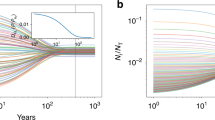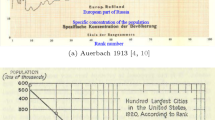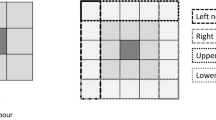Abstract
The exact shape of the distribution of city size is subject to considerable scholarly debate, as competing theoretical models yield different implications. The alternative distributions being tested are typically the Pareto and the log-normal, whose finite sample upper tail behavior is very difficult to tell apart. Using data at different levels of aggregation (census blocks and cities) we show that the tail behavior of the distribution changes upon aggregation, and the final result depends crucially on the shape of the distribution of the number of elementary units associated with each aggregate element.
Access this chapter
Tax calculation will be finalised at checkout
Purchases are for personal use only
Similar content being viewed by others
Notes
- 1.
This point is particularly stressed in Rozenfeld et al. (2011), who propose a new methodology to define cities based on microdata and a clustering algorithm that identifies a city as the maximal connected cluster of populated sites. By applying this methodology to both US and UK data, the authors find that a Zipf’s law approximates well the distribution of 1,947 US cities with more than 12,000 inhabitants (1,007 cities with more than 5,000 inhabitants for the UK). An alternative approach entails the use of high-resolution night-light satellite image data (Bagan and Yamagata 2015; Zhou et al. 2015).
- 2.
- 3.
In the rest of the chapter the terms city and populated place are used interchangeably.
- 4.
We thank an anonymous referee for highlighting this important point.
- 5.
- 6.
Such a conclusion is partially tempered by results of the GI test, which finds a power-law tail limited to the top 655 observations in the sampled dataset.
- 7.
See Asmussen and Rojas-Nandayapa (2008) for some asymptotic results in the special case of log-normal random variables with dependence structure given by the Gaussian copula.
- 8.
For a discussion of the role of increasing and decreasing returns to scale in determining the size of cities, see Masahisa et al. (2001, p. 225).
References
Aoki, M. and Yoshikawa, H. (2011). Reconstructing macroeconomics: a perspective from statistical physics and combinatorial stochastic processes. Cambridge University Press.
Asmussen, S. and Rojas-Nandayapa, L. (2008). Sums of dependent lognormal random variables: Asymptotics and simulation. Statistics & Probability Letters, 78:2709–2714.
Axtell, R. L. (2001). Zipf distribution of U.S. firm sizes. Science, 293(5536):1818–1820.
Bagan, H. and Yamagata, Y. (2015). Analysis of urban growth and estimating population density using satellite images of nighttime lights and land-use and population data. GIScience & Remote Sensing, 52(6):765–780.
Bee, M., Riccaboni, M., and Schiavo, S. (2011). Pareto versus lognormal: A maximum entropy test. Physical Review E, 84:026104.
Bee, M., Riccaboni, M., and Schiavo, S. (2013). The size distribution of US cities: Not Pareto, even in the tail. Economics Letters, 120(2):232–237.
Benhabib, J., Bisin, A., and Zhu, S. (2011). The distribution of wealth and fiscal policy in economies with finitely lived agents. Econometrica, 79(1):123–157.
Berry, B. J. and Okulicz-Kozaryn, A. (2012). The city size distribution debate: Resolution for US urban regions and megalopolitan areas. Cities, 29(Supplement 1):S17–S23.
Cabral, L. M. B. and Mata, J. (2003). On the evolution of the firm size distribution: Facts and theory. American Economic Review, 93(4):1075–1090.
Calderín-Ojeda, E. (2016). The distribution of all French communes: A composite parametric approach. Physica A: Statistical Mechanics and its Applications, 450:385–394.
Champernowne, D. G. (1953). A model of income distribution. The Economic Journal, 63(250):318–351.
Cieślik, A. and Teresiński, J. (2016). Does Zipf’s law hold for Polish cities? Miscellanea Geographica, 20(4):5–10. Cited By 0.
Cox, D. R. and Hinkley, D. V. (1974). Theoretical Statistics. Chapman and Hall.
Del Castillo, J. and Puig, P. (1999). The best test of exponentiality against singly truncated normal alternatives. Journal of the American Statistical Association, 94:529–532.
Eeckhout, J. (2004). Gibrat’s law for (all) cities. American Economic Review, 94(5):1429–51.
Eeckhout, J. (2009). Gibrat’s law for (all) cities: Reply. American Economic Review, 99(4):1676–83.
Embrechts, P., Klüppelberg, C., and Mikosch, T. (1997). Modelling Extremal Events for Insurance and Finance. Springer.
Fazio, G. and Modica, M. (2015). Pareto or log-normal? best fit and truncation in the distribution of all cities. Journal of Regional Science, 55(5):736–756.
Gabaix, X. (1999). Zipf’s law for cities: An explanation. Quarterly Journal of Economics, 114(3):739–67.
Gabaix, X. (2009). Power laws in economics and finance. Annual Review of Economics, 1:255–93.
Gabaix, X. (2011). The granular origins of aggregate fluctuations. Econometrica, 79:733–772.
Gabaix, X. and Ibragimov, R. (2011). Rank-1/2: A simple way to improve the OLS estimation of tail exponents. Journal of Business and Economic Statistics, 29(1):24–39.
Gibrat, R. (1931). Les Inegalites Economiques. Sirey, Paris.
González-Val, R., Ramos, A., Sanz-Gracia, F., and Vera-Cabello, M. (2015). Size distributions for all cities: Which one is best? Papers in Regional Science, 94(1):177–196.
Growiec, J., Pammolli, F., Riccaboni, M., and Stanley, H. E. (2008). On the size distribution of business firms. Economics Letters, 98(2):207–212.
Hsu, W.-T. (2012). Central place theory and city size distribution. The Economic Journal, 122(563):903–932.
Ijiri, Y. and Simon, H. A. (1977). Skew Distributions and the Sizes of Business Firms. North Holland, Amsterdam.
Ioannides, Y. and Skouras, S. (2013). US city size distribution: Robustly Pareto, but only in the tail. Journal of Urban Economics, 73(1):18–29.
Levy, M. (2009). Gibrat’s law for (all) cities: Comment. American Economic Review, 99(4):1672–75.
Li, X. and Nam, K.-M. (2017). One country, two “urban” systems: focusing on bimodality in China’s city-size distribution. Annals of Regional Science, 59(2):427–452.
Luckstead, J., Devadoss, S., and Danforth, D. (2017). The size distributions of all Indian cities. Physica A: Statistical Mechanics and its Applications, 474:237–249. Cited By 1.
Luttmer, E. G. (2007). Selection, growth, and the size distribution of firms. Quarterly Journal of Economics, 122(3):1103–1144.
Malevergne, Y., Pisarenko, V., and Sornette, D. (2009). Gibrat’s law for cities: uniformly most powerful unbiased test of the Pareto against the lognormal. Swiss Finance Institute Research Paper Series, pages 09–40.
Malevergne, Y., Pisarenko, V., and Sornette, D. (2011). Testing the Pareto against the lognormal distributions with the uniformly most powerful unbiased test applied to the distribution of cities. Physical Review E, 83(3):036111.
Masahisa, F., Krugman, P., and Venables, A. J. (2001). The Spatial Economy: Cities, Regions, and International Trade. The MIT Press.
Pareto, V. (1896). Cours d’économie politique professé à l’Université de Lausanne. F. Rouge, Lausanne.
Perline, R. (2005). Weak and false inverse power laws. Statistical Science, 20:68–88.
Puente-Ajovín, M. and Ramos, A. (2015). On the parametric description of the French, German, Italian and Spanish city size distributions. The Annals of Regional Science, 54(2):489–509.
Ramos, A. (2017). Are the log-growth rates of city sizes distributed normally? empirical evidence for the USA. Empirical Economics, 53(3):1109–1123.
Rozenfeld, H., Rybski, D., Gabaix, X., and Makse, H. (2011). The area and population of cities: New insights from a different perspective on cities. American Economic Review, 101(5):2205–25.
Sutton, J. (1997). Gibrat’s legacy. Journal of Economic Literature, 35(1):40–59.
Sutton, J. (2002). The variance of firm growth rates: the scaling puzzle. Physica A: Statistical Mechanics and its Applications, 312(3):577–590.
Wu, X. (2003). Calculation of maximum entropy densities with application to income distribution. Journal of Econometrics, 115:347–354.
Zhou, Y., Smith, S., Zhao, K., Imhoff, M., Thomson, A., Bond-Lamberty, B., Asrar, G., Zhang, X., He, C., and Elvidge, C. (2015). A global map of urban extent from nightlights. Environmental Research Letters, 10(5):054011. https://doi.org/10.1088/1748-9326/10/5/054011.
Zipf, G. K. (1949). Human Behavior and the Principle of Last Effort. Addison-Wesley, Cambridge: MA.
Author information
Authors and Affiliations
Corresponding author
Editor information
Editors and Affiliations
Rights and permissions
Copyright information
© 2019 Springer Nature Switzerland AG
About this chapter
Cite this chapter
Bee, M., Riccaboni, M., Schiavo, S. (2019). Distribution of City Size: Gibrat, Pareto, Zipf. In: D'Acci, L. (eds) The Mathematics of Urban Morphology. Modeling and Simulation in Science, Engineering and Technology. Birkhäuser, Cham. https://doi.org/10.1007/978-3-030-12381-9_4
Download citation
DOI: https://doi.org/10.1007/978-3-030-12381-9_4
Published:
Publisher Name: Birkhäuser, Cham
Print ISBN: 978-3-030-12380-2
Online ISBN: 978-3-030-12381-9
eBook Packages: Mathematics and StatisticsMathematics and Statistics (R0)




